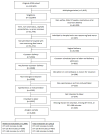The Association of Decision-to-Incision Time for Cesarean Delivery with Maternal and Neonatal Outcomes
- PMID: 28915515
- PMCID: PMC5801156
- DOI: 10.1055/s-0037-1606641
The Association of Decision-to-Incision Time for Cesarean Delivery with Maternal and Neonatal Outcomes
Abstract
Objective: The objective of this study was to estimate whether the decision-to-incision (DTI) time for cesarean delivery (CD) is associated with differences in maternal and neonatal outcomes.
Methods: This analysis is of data from women at 25 U.S. medical centers with a term, singleton, cephalic nonanomalous gestation and no prior CD, who underwent an intrapartum CD. Perinatal and maternal outcomes associated with DTI intervals of ≤ 15, 16 to 30, and > 30 minutes were compared.
Results: Among 3,482 eligible women, median DTI times were 46 and 27 minutes for arrest and fetal indications for CD, respectively (p < 0.01). Women with a fetal indication whose DTI interval was > 30 minutes had similar odds to the referent group (DTI of 16-30 minutes) for the adverse neonatal and maternal composites (odds ratio [OR]: 0.83, 95% confidence interval [CI]: 0.40-1.71 and OR: 0.89, 95% CI: 0.63-1.27). For arrest disorders, the odds of the adverse neonatal composite were lower among women with a DTI of > 30 minutes (OR: 0.25, 95% CI: 0.08-0.77), and the adverse maternal composite was no different (OR: 1.15, 95% CI: 0.81-1.63).
Conclusion: In this analysis, DTI times longer than 30 minutes were not associated with worse maternal or neonatal outcomes.
Thieme Medical Publishers 333 Seventh Avenue, New York, NY 10001, USA.
Conflict of interest statement
Disclosure The authors report no conflicts of interest in this work.
Figures
Similar articles
-
The effect of spinal hypotension and anesthesia-to-delivery time interval on neonatal outcomes in planned cesarean delivery.Am J Obstet Gynecol. 2020 Nov;223(5):747.e1-747.e13. doi: 10.1016/j.ajog.2020.08.005. Epub 2020 Aug 11. Am J Obstet Gynecol. 2020. PMID: 32791121
-
Association of Cerclage with Composite Adverse Outcomes among Women Delivered at 36 Weeks or Later.Am J Perinatol. 2020 Dec;37(14):1400-1410. doi: 10.1055/s-0040-1712962. Epub 2020 Jun 10. Am J Perinatol. 2020. PMID: 32521562
-
Is Faster Better? Relationships of Cesarean Acuity with Risk of Low Apgar Scores and Fetal Acidemia.Am J Perinatol. 2024 May;41(S 01):e1925-e1934. doi: 10.1055/a-2088-5393. Epub 2023 May 8. Am J Perinatol. 2024. PMID: 37156530
-
Cesarean delivery or induction of labor in pre-labor twin gestations: a secondary analysis of the twin birth study.BMC Pregnancy Childbirth. 2020 Nov 17;20(1):702. doi: 10.1186/s12884-020-03369-x. BMC Pregnancy Childbirth. 2020. PMID: 33203367 Free PMC article. Clinical Trial.
-
The intrapartum and perinatal risks of sleep-disordered breathing in pregnancy: a systematic review and metaanalysis.Am J Obstet Gynecol. 2018 Aug;219(2):147-161.e1. doi: 10.1016/j.ajog.2018.02.004. Epub 2018 Feb 15. Am J Obstet Gynecol. 2018. PMID: 29454869
Cited by
-
Implementation of a crash cesarean section policy and its impact on maternal and neonatal outcomes at King Abdulaziz University Hospital: A retrospective study.Medicine (Baltimore). 2024 Nov 29;103(48):e40645. doi: 10.1097/MD.0000000000040645. Medicine (Baltimore). 2024. PMID: 39612466 Free PMC article.
-
Association between decision-to-delivery time and neonatal outcomes: a systematic review and meta-analysis.BMC Pregnancy Childbirth. 2024 Jun 7;24(1):410. doi: 10.1186/s12884-024-06603-y. BMC Pregnancy Childbirth. 2024. PMID: 38849748 Free PMC article.
-
Evaluating the Decision-to-Delivery Interval in Emergency Cesarean Sections and its Impact on Neonatal Outcome.In Vivo. 2020 Nov-Dec;34(6):3341-3347. doi: 10.21873/invivo.12172. In Vivo. 2020. PMID: 33144441 Free PMC article.
-
Maternal caesarean section infection (MACSI) in Sierra Leone: a case-control study.Epidemiol Infect. 2020 Feb 27;148:e40. doi: 10.1017/S0950268820000370. Epidemiol Infect. 2020. PMID: 32102721 Free PMC article.
References
-
- Arora KS, Shields LE, Grobman WA, D’Alton ME, Lappen JR, Mercer BM. Triggers, bundles, protocols, and checklists--what every maternal care provider needs to know. Am J Obstet Gynecol. 2016;214:444–51. - PubMed
-
- Gumbinger C, Reuter B, Stock C, et al. Time to treatment with recombinant tissue plasminogen activator and outcome of stroke in clinical practice: retrospective analysis of hospital quality assurance data with comparison with results from randomised clinical trials. BMJ. May 30;348:g3429. - PMC - PubMed
-
- Saver JL, Fonarow GC, Smith EE, et al. Time to treatment with intravenous tissue plasminogen activator and outcome from acute ischemic stroke. JAMA. 2013;309:2480–2488. - PubMed
-
- American College of Obstetrics and Gynecologists Committee on Professional Standards. Standards for obstetric-gynecologic services. 7. Washington, DC: 1989.
Publication types
MeSH terms
Grants and funding
- U10 HD040500/HD/NICHD NIH HHS/United States
- UG1 HD027869/HD/NICHD NIH HHS/United States
- U10 HD040544/HD/NICHD NIH HHS/United States
- UG1 HD040560/HD/NICHD NIH HHS/United States
- UG1 HD087230/HD/NICHD NIH HHS/United States
- UG1 HD053097/HD/NICHD NIH HHS/United States
- UG1 HD027915/HD/NICHD NIH HHS/United States
- U10 HD040485/HD/NICHD NIH HHS/United States
- U10 HD034116/HD/NICHD NIH HHS/United States
- U10 HD027869/HD/NICHD NIH HHS/United States
- U10 HD027917/HD/NICHD NIH HHS/United States
- UG1 HD040485/HD/NICHD NIH HHS/United States
- U10 HD040560/HD/NICHD NIH HHS/United States
- UG1 HD040500/HD/NICHD NIH HHS/United States
- U10 HD040512/HD/NICHD NIH HHS/United States
- U10 HD040545/HD/NICHD NIH HHS/United States
- U01 HD036801/HD/NICHD NIH HHS/United States
- U10 HD053118/HD/NICHD NIH HHS/United States
- UL1 RR024989/RR/NCRR NIH HHS/United States
- UL1 RR025764/RR/NCRR NIH HHS/United States
- UG1 HD034116/HD/NICHD NIH HHS/United States
- UG1 HD040544/HD/NICHD NIH HHS/United States
- UG1 HD034208/HD/NICHD NIH HHS/United States
- UG1 HD040512/HD/NICHD NIH HHS/United States
- U10 HD027915/HD/NICHD NIH HHS/United States
- UG1 HD040545/HD/NICHD NIH HHS/United States
- U10 HD034208/HD/NICHD NIH HHS/United States
- U10 HD053097/HD/NICHD NIH HHS/United States
- U10 HD021410/HD/NICHD NIH HHS/United States
- U10 HD036801/HD/NICHD NIH HHS/United States
- U24 HD036801/HD/NICHD NIH HHS/United States
LinkOut - more resources
Full Text Sources
Other Literature Sources
Medical


